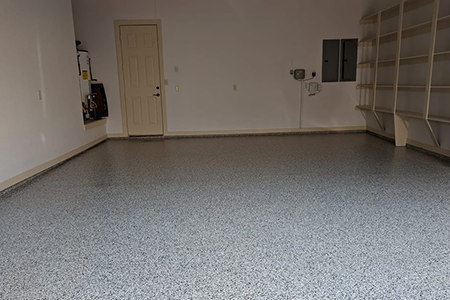Garage Floor Paint: It’s More Than What’s on the Surface
Transforming the look and feel of your garage often begins with the floor. This heavily-used, often neglected, and extremely important surface sometimes doesn’t get the attention it deserves. After all, you’ve literally been walking — and driving — all over it. While painting the floor improves the overall appearance of the space without a doubt, there are additional benefits, and understanding a few things about garage floor paint and coatings will help you achieve the best possible result. Garage floor paint is more than what’s on the surface.

Epoxy Coating
Epoxy is a very strong glue used in a variety of applications which gives the material it’s added to more strength. Though sometimes confused with paint, it isn’t, although it is sometimes added to paint for extra resilience. Using an epoxy for your garage floor is superior than applying paint alone because of its durability. Not only does it bring shine and beauty to the floor, making it look brand new, it’s also resistant to chipping, staining, or abrading. So you don’t need to worry about the impact of dropped tools or contact with chemicals such as oil or gasoline.
Colored Acrylic Flakes
Adding colored flakes to your epoxy coating can help you create the perfect, custom, garage floor. The paint chips can be applied in different ways depending on the base color of the floor and how much you want it to show through. Adding a small amount of colored flakes will provide minimal coverage of the base coat, while using the maximum amount will cover it completely. For example, if you have a gray floor, using a minimal amount of black and white chips would result in a gray floor with black and white specks. Consult your flooring professional for how to determine the correct ratio of acrylic flakes.
Polyurethane Coating
A polyurethane coating (also called urethane) is also a good choice for garage floors because of its durability and scratch resistance. It’s actually more flexible than epoxy and absorbs impacts better. Polyurethane won’t yellow when exposed to sunlight consistently like epoxy can, and it has a wider range of temperature tolerance. However, polyurethane doesn’t adhere to concrete well and dries in a thin coating which isn’t ideal for filling cracks. It’s also a solvent (a substance which can dissolve other liquids or materials) and gives off fumes when applied, so proper protective wear must be worn. But with a properly prepared surface, a polyurethane coating might be the better choice for some floors.
So how do you choose the right floor coating for your garage? Consult with the pros. Flores Decorative Concrete will walk you through every step of the process. Contact us for a garage-floor makeover today. It’s More Than What’s on the Surface
